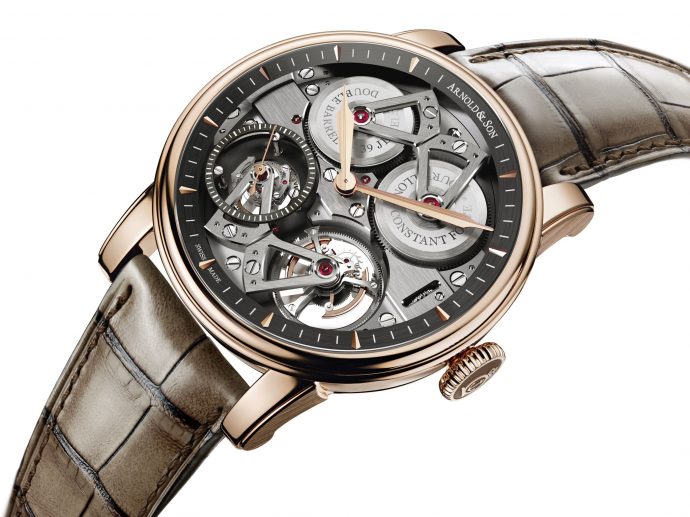Categories more
- Adventures (16)
- Arts / Collectables (15)
- Automotive (37)
- Aviation (11)
- Bath, Body, & Health (76)
- Children (6)
- Cigars / Spirits (32)
- Cuisine (16)
- Design/Architecture (21)
- Electronics (12)
- Entertainment (4)
- Event Planning (5)
- Fashion (44)
- Finance (9)
- Gifts / Misc (6)
- Home Decor (44)
- Jewelry (40)
- Pets (3)
- Philanthropy (1)
- Real Estate (14)
- Services (22)
- Sports / Golf (14)
- Vacation / Travel (60)
- Watches / Pens (14)
- Wines / Vines (24)
- Yachting / Boating (16)
Published
06/13/2019 by Arnold & SonIts historical roots, aesthetic construction and true-beat seconds ascribe the Arnold & Son Constant Force Tourbillon to the tradition of ultra-accurate marine chronometers. It's practicality – in terms of both readability and accuracy – has been clearly proven.
When John Arnold developed marine chronometers that would mark the history of navigation in the 1780s, he had to create high-precision systems that had both a long lifespan and an appropriate display scale to ensure the utility of the chronometry they provided. He therefore decided on a constant force mechanism paired with true-beat seconds.
Constant force involves inserting an energy-storage sub-system into the gear train just before the escapement. Supplied at regular intervals, this secondary reservoir produces extremely regular torque as it is released in consistent, small doses. It therefore differs from the barrels’ energy flow, which is delivered over a long period of time and naturally fluctuates. The balance spring thus receives an invariable source of energy, hence the name “Constant Force”.
The true-beat seconds is a consequence of this mechanism. As the constant force system is reloaded 60 times per minute, it is possible to display a second that jumps forward from marker to marker by simply attaching a hand to the winding wheel. Despite being a common feature of quartz watches, it remains a rare feat in mechanical timepieces.
On maps
This precise reading proved extremely useful for maritime positioning in the 18th century. The difference between the local time (measured by the position of the sun) and the reference time (kept by a clock) gave the distance traveled along the east-west axis of the earth. Or in other words, a vessel's longitude. The creation of marine chronometers allowed captains to know their position and, more importantly, to know how far away they were from a deadly reef or shallow waters.
Given the scale of transoceanic navigation, every second counted, as each represented a potential error of hundreds of miles. There was no point in a timepiece being accurate if its information display was not equally as precise. Because a true-beat seconds hand stays immobile for an entire second, its readings were all the more accurate.
In its design 230 years later, Arnold & Son continues to use this device in a model that incorporates all existing solutions for supreme chronometric results: the Constant Force Tourbillon. Its A&S5119 calibre adopts the same characteristic layout as John Arnold's marine chronometers. It testifies to the mechanism's inner arrangement through technical prowess and symmetry, which go hand-in-hand with performance and precision.
The two series-coupled barrels are located at 11:30 and 1:30. When the force supplied by the first barrel falls below a predefined threshold, the second barrel reinforces it to smooth out the central – and longest – part of the torque. In addition, the A&S5119 calibre features a patented constant force wheel at 7:30, which is supplied with power every second. It can be seen under the truebeat seconds hand (a complication that is naturally also included) and can be identified by the anchor that acts as the winding mechanism's satellite carrier – a symbol that is precious to Arnold & Son in relation to its maritime heritage.
This constant force wheel supplies the regulating organ of the Constant Force Tourbillon, a one minute tourbillon that beats at a frequency of 3 Hz and is located at 4:30. By rotating and adopting every position in order to establish an average, the system reduces the detrimental effects of gravity on the parts in the regulating organ. As well as lending prestige to the watch, it also constitutes a source of chronometry with high added watchmaking value.
In history
The combination of the three approaches with the barrels and the escapement in the space results in almost zero variation in amplitude over the entire power reserve of 90 hours – an extremely rare achievement. And yet, such consistency is a major determining factor in rate precision.
Measurements made using the Constant Force Tourbillon show an average daily rate variation of around 3 seconds. This is an error rate of less than 4 in 100,000. Once again, this Arnold & Son timepiece illustrates the power that the cultural and historical heritage of chronometry continues to wield.















